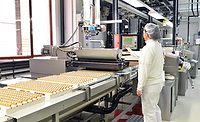In the face of terrorism, normal food safety issues become even more complex. Today, the biological organisms that threaten our food supply, such as Salmonella or e.coli, are often present in raw materials processed into other foods. This is acceptable when the processing steps kill the organisms. But terrorism adds another dimension. For example, terrorists probably would not taint a product with a biological agent just before the product entered an oil fryer, although they might look to contaminate an ingredient added after heat treatment stages.
We need to establish new prevention strategies that will limit the risk of intentional contamination and we need to improve our ability to contain contaminated product through new information technology intensive product recall strategies.
Here are some other key points to reinforce food security:
- Audit your HR hiring procedures regularly to ensure that all employees have valid I-9s
- Use employee identification methods for entry
- Examine all incoming ingredients and materials for evidence of tampering
- Include potential terrorist threats in your HACCP plan
- Put video cameras in places where employees come in contact with food products, especially after heat processing
- Register all visitors, monitor their activity and require them to wear special apparel
- Limit the number of entry points to your plant
- Improve visible levels of security — guards, lighting, check points, fences, etc.
- Train employees on food security issues on a regular basis.
In some ways, food security containment strategies are similar to food safety recall procedures. Many companies use paper-based recall procedures. In the future, manufacturers will need to have computer-based systems capable of “reverse engineering” all of the ingredients and process parameters from the product container to accommodate rapid recalls if food security is compromised.
There are some important plant information technology implications in developing new recall processes. For example, ingredient data from suppliers in the upstream supply chain will need to be captured in the ERP purchasing system and transferred to the appropriate plant data control points to be incorporated into the finished product lot information. Companies that can electronically track their ingredients from farm-to-consumer and back from consumer-to-farm will be able to demonstrate to government regulators and to the public that they have done due diligence in food security.
There is no question that improved physical security combined with improved electronic tracking of ingredients and finished goods through the supply chain will diminish the potential impact of a terrorist action. The reality is that it is a matter of risk management.



